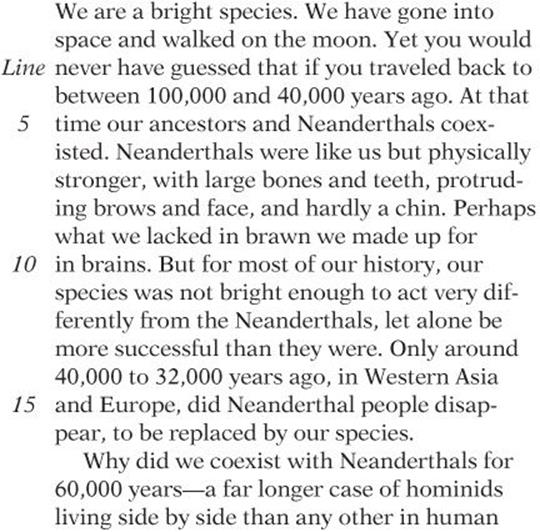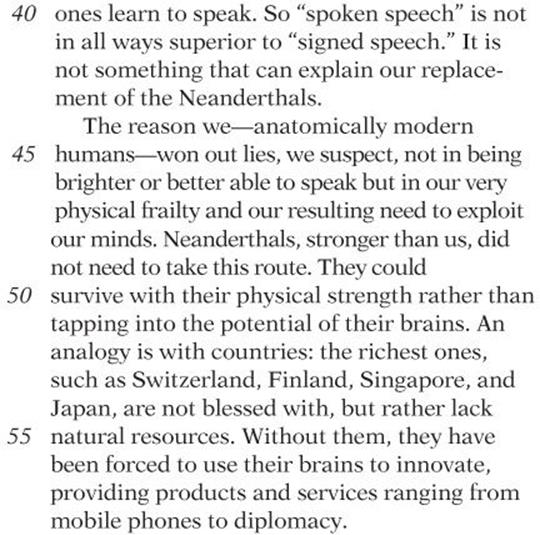SAT Test Prep
CHAPTER 4
CRITICAL READING SKILLS
Lesson 8: Checking That You”ve Nailed the Answer
Avoid the Choices That Are True but Wrong
Too often students make the mistake of choosing an answer that makes a true statement but does not answer the question correctly. How can that be? Imagine that you”ve read a passage written by an art critic praising a museum that has been harshly criticized by others. The passage acknowledges certain flaws in the planning and design of the building but on the whole praises the building for its innovations. Then you read a question like this:
The author uses the term “monstrosity” (line 4) primarily in order to
(A) justify the building of the museum
(B) characterize the opinion of certain critics
(C) express his dismay about certain decisions made by the planners
(D) disparage the work of certain architects
(E) praise the museum for its innovative design
Looking back to line 4, you read: “They could not understand how such a monstrosity could have been erected under their noses.” When you look at the passage as a whole, you see that the author does, in different places, “justify the building of the museum” (choice (A)), “characterize the opinion of certain critics” (choice (B)), “express his dismay about certain decisions made by the planners” (choice (C)), and “praise the museum for its innovative design” (choice (E)). These are all basically “true” statements. So how do you pick the right answer? Read the questioncarefully. It asks why the author uses the term “monstrosity.” Does the author think the museum is a monstrosity? No, because the passage as a whole praises the museum. The sentence in line 4 says that they—other critics—thought it was a monstrosity. Therefore, this word is being used to (B) characterize the opinion of certain critics.
Some choices may make statements that are true without being the correct answer to the question. Read the question very carefully to be sure you”ve answered what it asks. Carefully note the question type, as discussed in Lesson 5.
Underline Your Evidence
It”s worth repeating: To check your answers, underline your evidence in the passage. This forces you to focus on what is in the passage and not what is just in your head. The right answers are always right there in the passage, if you look for them. You never need to draw on outside knowledge or read between the lines.
Keep Your Eyes on the Prize
Always check your progress in terms of your score goal. Unless you”ve got a realistic shot at an 800, you don”t need to get every question right. Don”t get bogged down on tough questions. If you can”t decide between two answers, make your best guess and move on. Keep in mind that to break 500, you need only to get about half of the questions right, and to break 600, you need to get only about two-thirds of the questions right. To break 700, though, you”ll need to get more than 86% of the questions right.
In addition to checking individual answers, check that you”ve carefully attacked at least the number of questions that you should according to your “SAT Study Plan.”
Learn to Deal with “Space-Outs”
Nearly everyone “spaces out” from time to time when they read. Have you ever suddenly realized that you”ve “read” three paragraphs but nothing has sunk in? This is costly only if you panic and let it distract you for the rest of the test.
If you space out a little on the SAT reading, relax. It happens to everyone, and you”ll be fine if you don”t panic. Just calmly go back to where you left off, and reread normally. To minimize space-outs, just focus on answering the three key questions and summarizing each paragraph. When your brain has a conscious task, it doesn”t space out.
Concept Review 8: Checking That You”ve Nailed the Answer
1. What does it mean for an answer to be “true” but “wrong”?
2. How do you avoid choices that are “true” but “wrong”?
3. Why is it helpful to underline evidence for your answers in the passage?
4. What is your score goal on the SAT CR section, and what percentage of the questions should you attack in order to get that score?
5. How should you deal with “space-outs” on the CR section?
SAT Practice 8: Checking That You”ve Nailed the Answer
The following passage is taken from a book written in 2002 about the evolution of human intelligence.



1. The main purpose of the second paragraph (lines 17–43) is to
(A) make a suggestion
(B) examine some claims
(C) explain a situation
(D) present information objectively
(E) tell a story
2. In line 20, the phrase “win out” most nearly means
(A) become justified
(B) defeat their foes by force
(C) come to dominate
(D) become politically successful
(E) become more popular
3. The evidence in lines 34–36 (“Anthropologists find … speech”) is presented primarily in order to
(A) refute the misconception that huntergatherers were not good communicators
(B) explain how modern humans replaced the Neanderthals
(C) support the claim that hunter-gatherers have larger brains than Neanderthals
(D) suggest that long vocal chambers may not provide an advantage to a particular species
(E) show why some humans prefer gestures to spoken language
John R. Skoyles and Dorion Sagan, Up from Dragons. © 2002 McGraw-Hill. Reprinted by permission of The McGraw-Hill Companies.
4. The “physical frailty” in line 47 is
(A) the reason our ancestors struggled to survive
(B) the result of a harsh physical environment
(C) an ironic advantage to modern humans
(D) something the Neanderthals exploited
(E) a trait that arose late in human history
5. In line 58, “mobile phones” and “diplomacy” are mentioned as examples of
(A) innovations that are used worldwide
(B) different ways of communicating
(C) luxuries that are denied to the physically frail
(D) inventions that Neanderthals could never use
(E) products or services that require intellectual rather than natural resources
Answer Key 8: Checking That You”ve Nailed the Answer
Concept Review 8
1. An answer is “true” but “wrong” if it reflects a point that is made in the passage but does not answer the question that is asked. Such answers are very common on SAT Critical Reading questions.
2. You can avoid the trap of choosing a “true” but “wrong” answer by reading the question very carefully and focusing on the specific line references it mentions and on the question it asks.
3. Underlining the evidence in the passage helps you to focus on what is in the passage rather than what is in your head.
4. The percentage of questions that should be attacked to get particular score goals are as follows: ![]() ,
, ![]() ,
, ![]() ,
, ![]() and above = 100%.
and above = 100%.
5. First, don”t panic. When you notice that you have spaced out, calmly come back to the point where you left off and continue to read. The key to avoiding “space-outs” in the first place is to focus on answering the three key questions and summarizing each paragraph.
SAT Practice 8
1. B Words and phrases such as “perhaps” (line 23), “if” (line 26), and “maybe not” (line 28) indicate that the second paragraph is examining hypotheses.
2. C The passage explores the question of how modern humans came to “win out” (line 20) over the Neanderthals, that is, how they came to thrive while the Neanderthals died out, or how they came to dominate them.
3. D The sentence “Anthropologists find … speech” (lines 34–36) is used to support the later claim that ““spoken speech” is not in all ways superior to “signed speech”” (lines 40–41), which would cast doubt on the advantages of the “long vocal chamber needed for speech” (lines 23–24).
4. C According to the final paragraph, the relative “physical frailty” (line 47) of modern humans compared to Neanderthals created a need for modern humans to “tapping … into the potential of their brains” (line 51), which led to their dominance over the Neanderthals.
5. E The “mobile phones” and “diplomacy” in line 58 are examples of how countries that “lack natural resources” (lines 54–55) can still “use their brains to innovate” (line 56).
1Benefit
2Related to church matters